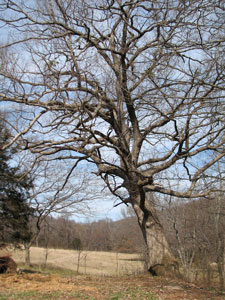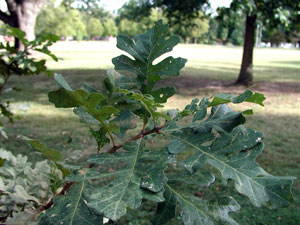Resource Library
Plant of the Week: Oak, Bur (Burr, Mossycup Oak)
The University of Arkansas System Division of Agriculture does not promote, support or recommend plants featured in "Plant of the Week." Please consult your local Extension office for plants suitable for your region.
Plant of the Week
Bur Oak
Latin: Quercus macrocarpa

When Europeans arrived in North America, they found a great forest that, so far as they knew, extended across the continent. But when early explorers pushed west, they discovered that in the region we now call the Midwest, the forests gave way to open expanses of prairie. This transition from forest to prairie was not abrupt, but tapered off gradually and with a change in the nature of the forest. At the prairie fringe, the tree these early settlers encountered was the bur oak (Quercus macrocarpa).
Bur oak (also called burr or mossycup oak) is in the white oak section of the great oak family. It is a picturesque tree growing as wide as it is tall with deeply fissured gray or gray-brown bark on the massive trunks and major limbs. Trees usually grow no more than 80 feet tall and are short-trunked with side branching starting low on the bole.
Leaves of bur oak are 6 to 10 inches long, thick and coarse-textured with lobes on the lower portion of the leaf and a broader, less-lobed upper section, giving the leaf a club-like appearance. Fall color may be a modest yellow-brown. The acorns, the largest of the genus, can be as large as a golf ball, with a cap that encloses half or more of the acorn. The lower margin of the cap is deeply fringed. The acorns of bur oak, like all oaks in the white oak group, mature in one season - unlike the red oaks, which require two seasons to develop.
At the interface between prairie and forest, early settlers often found islands of trees - they naturally called them prairie groves - growing in the prairie. The natural range of the post oak is west of the Appalachians and as far south as east Texas and as far west as the Black Hills in South Dakota, but it occurs in its highest density in the upper Midwest. In the Midwest, the advance guard of the eastern forest was the bur oak; in the Ozarks and further south, this advance guard was usually post oak (Quercus stellata), a more drought- and heat-tolerant species. In Fayetteville, the post oaks in Agri Park represent the remnants of one of these natural islands of oaks.
These oak groves featured widely spaced trees, with prairie grass growing as a natural lawn beneath them. Competition from shrubs and seedlings of their own kind were kept at bay by frequent prairie fires that were either naturally caused or, more often, started by native tribes to maintain better grazing conditions for buffalo. Bur oaks have a thick, fire-resistant bark. Eventually the forest front caught up with these islands of trees, but the open nature of these stands remained, even when surrounded by a more typical mixed forest.

The early travelers called these oak openings, a name used by James Fenimore Cooper in his 1848 novel by the same name. In it, Cooper describes the experience of visiting a virgin oak grove in Michigan: “In the centre of the prairie is an ‘island’ of forest, containing some five or six hundred acres of the noblest native trees we remember ever to have seen. In the centre of this wood is a little lake, circular in shape, and exceeding a quarter of a mile in diameter. The walk in this wood, which is not an opening, but an old-fashioned virgin forest, we found delightful of a warm summer’s day.”
Bur oaks are the most common of the white oak section in the nursery trade, where it has found a niche as a specimen tree in areas with difficult growing conditions. It is tolerant of difficult city conditions and drought, and grows in heavy clay soils, even with an alkaline pH. It grows on average about one foot a year, making it one of the faster-growing white oaks, but slow-growing by red oak standards. Bur oak trees typically live 300 years, making up for its tardy growth rate. It is winter-hardy from zone 3 through 7.
By: Gerald Klingaman, retired
Retired Extension Horticulturist - Ornamentals
Extension News - May 20, 2011
The University of Arkansas System Division of Agriculture does not maintain lists of retail outlets where these plants can be purchased. Please check your local nursery or other retail outlets to ask about the availability of these plants for your growing area.